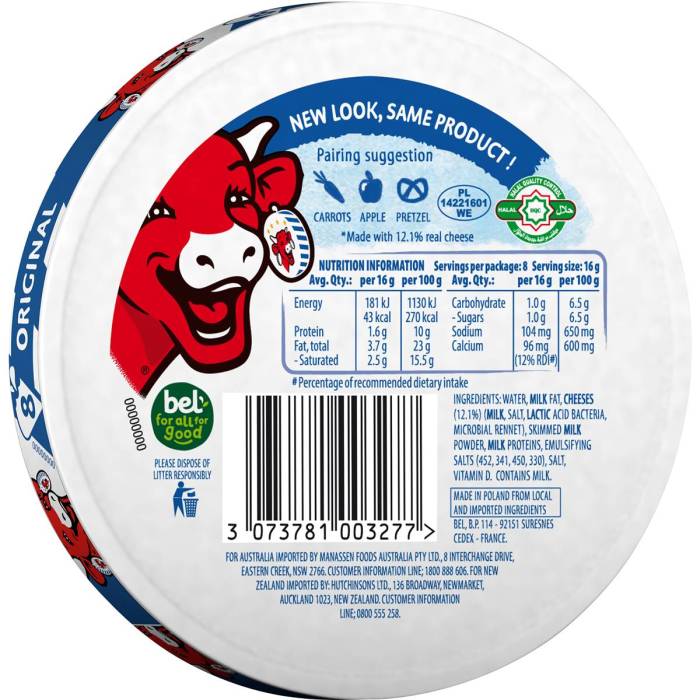Laughing Cow Cheese in a Balanced Diet

Light laughing cow cheese nutrition – Laughing Cow cheese, with its convenient single-serving portions, can be a part of a balanced diet, but mindful consumption is key due to its fat and sodium content. Understanding its nutritional profile and how it compares to other dairy options allows for informed choices.
Laughing Cow Cheese’s Nutritional Role
Laughing Cow cheese provides a source of calcium and protein, essential for bone health and muscle building. However, it’s higher in fat and sodium than some other dairy choices. A balanced diet incorporates it sparingly as part of a broader intake of fruits, vegetables, whole grains, and lean protein. Over-consumption can contribute to weight gain and high blood pressure if not balanced with other healthier food choices.
Light Laughing Cow cheese offers a convenient, portion-controlled source of calcium and protein, perfect for a mindful snack. However, if you’re looking for a heartier meal with similar cheesy satisfaction, consider comparing its nutritional profile to something like a Subway steak and cheese; check out the detailed nutritional breakdown here: nutrition subway steak and cheese. Ultimately, choosing between the two depends on your individual dietary needs and desired calorie intake, but understanding both nutritional profiles empowers smarter snacking choices.
Portion control is crucial.
Comparison to Other Dairy Products
Compared to cheeses like cheddar or mozzarella, Laughing Cow typically has a lower fat content per serving, although the saturated fat content might be similar. It also tends to be lower in calories. However, it often has a higher sodium content than many other cheeses. Greek yogurt, for instance, offers a higher protein content with lower fat and sodium, while milk provides calcium and other nutrients with lower fat options available.
The choice depends on individual dietary needs and preferences.
Sample Meal Plan Incorporating Laughing Cow Cheese
A balanced meal plan can easily incorporate Laughing Cow cheese in moderation. The following examples showcase its versatility:
- Breakfast: Whole-wheat toast with Laughing Cow cheese and sliced tomato. This provides carbohydrates, protein, and healthy fats. The tomato adds vitamins and antioxidants.
- Lunch: A large salad with mixed greens, grilled chicken or chickpeas, and a Laughing Cow cheese wedge. This offers a balance of protein, fiber, and healthy fats. The cheese adds a creamy texture and flavor.
- Snack: Laughing Cow cheese with a small handful of almonds or celery sticks. This combination offers protein, healthy fats, and fiber to keep you feeling full and satisfied between meals.
- Dinner: A light quiche with vegetables and a small amount of Laughing Cow cheese mixed into the egg mixture. This incorporates the cheese into a larger, more balanced meal.
Serving Suggestions and Culinary Applications

Laughing Cow cheese, with its creamy texture and mild flavor, offers surprising versatility beyond simply spreading it on crackers. Its convenient individual portions make it ideal for quick snacks and creative additions to various dishes, enhancing both taste and nutritional value. This section explores delicious and healthy ways to incorporate Laughing Cow cheese into your daily meals.
Creative Snack and Appetizer Ideas, Light laughing cow cheese nutrition
Laughing Cow’s portability makes it perfect for on-the-go snacks. Pair a wedge with sliced vegetables like bell peppers or cucumbers for a refreshing and nutritious bite. For a more substantial snack, spread it on whole-wheat crackers or crispbreads alongside sliced tomatoes and a sprinkle of herbs. Consider adding it to a quick avocado toast for a creamy, savory twist.
The mild flavor complements many ingredients, allowing for endless possibilities.
FAQ Explained: Light Laughing Cow Cheese Nutrition
Is Laughing Cow cheese good for weight loss?
The light version can be part of a weight-loss plan due to its lower fat and calorie content, but portion control is key.
Is Laughing Cow cheese suitable for lactose-intolerant individuals?
Laughing Cow cheese contains lactose, so it may not be suitable for those with severe lactose intolerance. Check the ingredient list for specific information.
Can I eat Laughing Cow cheese every day?
Moderation is key. Daily consumption should consider sodium and saturated fat intake limits, especially for individuals with health concerns.
What are the best ways to store Laughing Cow cheese?
Refrigerate unopened and opened packages. Consume opened wedges within a few days for optimal freshness and safety.


